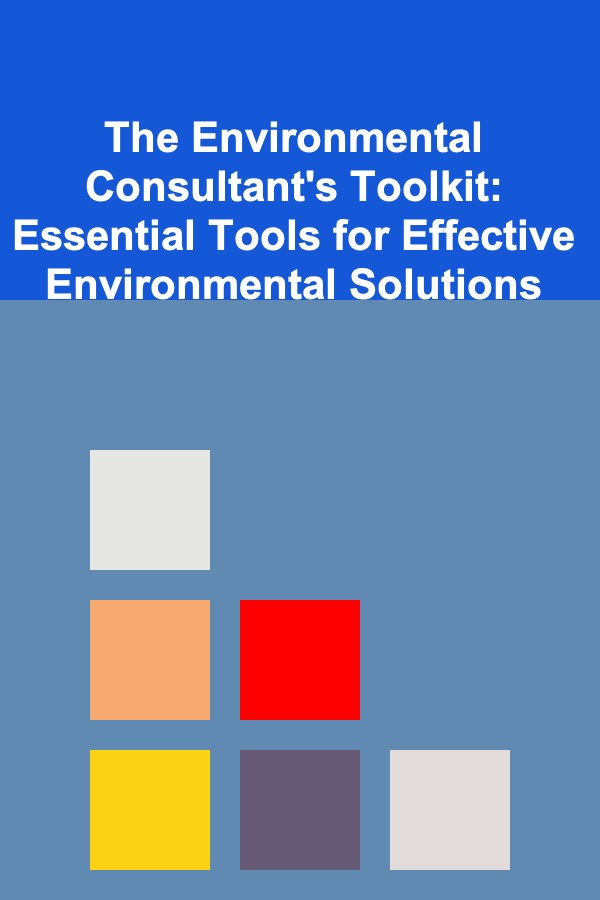
The Environmental Consultant's Toolkit: Essential Tools for Effective Environmental Solutions
ebook include PDF & Audio bundle (Micro Guide)
$12.99$11.99
Limited Time Offer! Order within the next:

Environmental consulting has grown into a multifaceted field that requires a diverse set of skills and tools to address the unique challenges presented by clients across industries. Whether it's helping companies comply with environmental regulations, reduce their carbon footprint, or develop sustainable practices, environmental consultants need a comprehensive toolkit. This toolkit is built upon a combination of data collection methods, analytical tools, environmental models, and communication techniques that together enable consultants to offer actionable, impactful, and cost-effective solutions.
In this actionable guide, we will explore the essential tools every environmental consultant should have at their disposal to provide effective environmental solutions. These tools are organized into five key categories: data collection and monitoring, analysis and modeling, regulatory compliance, sustainability practices, and communication strategies. Each of these tools plays a crucial role in delivering high-quality, impactful environmental consulting.
Data Collection and Monitoring Tools
The foundation of any environmental consultancy is data. Collecting accurate, real-time data is essential for assessing environmental conditions, understanding risks, and measuring the effectiveness of implemented strategies. The following tools are key for gathering relevant environmental data:
Environmental Monitoring Systems (EMS)
Environmental Monitoring Systems (EMS) are crucial for tracking and assessing various environmental parameters, including air quality, water quality, noise pollution, and soil health. These systems collect data continuously and in real time, providing consultants with a comprehensive view of the environmental conditions.
- Air Quality Sensors: These sensors measure pollutants such as carbon dioxide (CO2), nitrogen dioxide (NO2), sulfur dioxide (SO2), particulate matter (PM), and ozone levels in the atmosphere. They are essential for air quality assessments, especially in urban areas or industrial sites.
- Water Quality Monitors: These tools measure factors such as pH, dissolved oxygen, turbidity, and contaminants like nitrates, phosphates, and heavy metals in water bodies. They help assess the health of rivers, lakes, and groundwater systems.
- Soil and Groundwater Sensors: These sensors are used to assess the quality of soil and groundwater, including the detection of toxic substances, pollutants, or changes in the soil's structure.
By employing EMS, consultants can continuously monitor environmental variables and obtain real-time data for accurate assessments and decision-making.
Remote Sensing and Geographic Information Systems (GIS)
Remote sensing technologies, often paired with GIS, provide powerful capabilities for environmental consultants to gather and analyze spatial data.
- Satellite Imagery: Satellite images offer valuable insights into land use, deforestation, urban sprawl, and agricultural practices. Remote sensing satellites like Landsat or Sentinel can help monitor large geographical areas and detect changes in the environment over time.
- GIS Software: GIS platforms (e.g., ArcGIS, QGIS) allow environmental consultants to create maps, visualize data, and perform spatial analysis. These systems integrate various datasets, including satellite imagery, topographic maps, and climate data, to aid in decision-making.
Together, remote sensing and GIS provide consultants with the tools to assess landscape changes, identify environmental risks, and make informed recommendations based on spatial data.
Analysis and Modeling Tools
Once data has been collected, environmental consultants need advanced analytical tools to interpret and model environmental scenarios. These tools help in predicting potential environmental impacts, evaluating mitigation strategies, and understanding trends.
Environmental Impact Assessment (EIA) Tools
Environmental Impact Assessments (EIA) are essential for evaluating the potential consequences of a proposed project on the environment. Consultants rely on specialized EIA software and methodologies to predict and analyze various environmental impacts, including:
- Hydrological Modeling Tools: These tools simulate water flow, groundwater movement, and water quality in relation to land development, industrial operations, or agricultural activities. Hydrological models, such as HEC-HMS or SWMM, help predict the impact of rain, runoff, and pollution on local water systems.
- Air Dispersion Models: Air dispersion models (e.g., AERMOD, CALPUFF) simulate how air pollutants disperse in the atmosphere based on factors like wind speed, temperature, and topography. These models are vital for assessing the impact of industrial emissions on air quality.
- Biodiversity and Ecosystem Models: Tools like the InVEST (Integrated Valuation of Ecosystem Services and Trade-offs) model assess the impact of development on biodiversity and ecosystem services. These models simulate changes in ecosystem conditions based on land use, resource extraction, and conservation strategies.
Using EIA tools, consultants can evaluate the potential negative impacts of a project and recommend strategies to mitigate these effects before they occur.
Life Cycle Assessment (LCA) Tools
Life Cycle Assessment (LCA) is a comprehensive approach to evaluating the environmental impacts of a product or service throughout its entire lifecycle, from raw material extraction to disposal. LCA software helps consultants assess the environmental costs associated with every stage of a product's life.
- OpenLCA: An open-source software used for conducting LCA, allowing consultants to evaluate product sustainability and identify opportunities for reducing environmental impact.
- SimaPro: A widely used LCA software that provides a detailed analysis of energy consumption, emissions, and resource use throughout the product lifecycle. It is particularly useful for consultants advising on product design or supply chain sustainability.
By using LCA tools, consultants can identify areas where environmental impacts can be minimized, helping companies develop more sustainable products and processes.
Regulatory Compliance Tools
Environmental consultants play a vital role in ensuring that their clients comply with local, national, and international environmental regulations. Tools that assist in regulatory compliance help consultants navigate the complex web of environmental laws and standards.
Regulatory Databases and Compliance Management Software
Environmental laws are continually evolving, and staying up to date with these changes is critical for consultants. Specialized databases and compliance management software help track relevant regulations and ensure that clients meet their obligations.
- EnviroLinks: A regulatory database that provides up-to-date information on local and international environmental regulations, helping consultants stay informed about changes in environmental law.
- Envirosuite: A platform that integrates environmental monitoring with compliance reporting. It provides tools for consultants to track and manage regulatory requirements, ensuring that businesses stay compliant with environmental standards.
Emission and Waste Tracking Software
Managing emissions and waste is a key aspect of environmental compliance. Consultants use software to track pollutants and waste generated by industrial operations and ensure that businesses adhere to limits set by regulatory authorities.
- EcoReal: A tool for tracking energy consumption, emissions, and waste generation. It provides reports that can be submitted to regulatory bodies, ensuring clients remain compliant with carbon footprint regulations and waste management standards.
By leveraging these regulatory compliance tools, environmental consultants can help clients meet their legal obligations and avoid potential fines or penalties.
Sustainability Practices and Tools
In addition to compliance, environmental consultants are increasingly tasked with helping clients adopt sustainable practices that go beyond the minimum regulatory requirements. The tools used in this area support clients in achieving long-term sustainability goals.
Carbon Footprint Calculators and Sustainability Reporting Tools
Tracking and reducing carbon emissions is a primary goal for many companies striving to be more sustainable. Carbon footprint calculators help businesses assess their emissions from operations, supply chains, and products.
- GHG Protocol: The Greenhouse Gas (GHG) Protocol is an internationally recognized standard for measuring and managing greenhouse gas emissions. Consultants use this protocol to calculate direct and indirect emissions across a company's operations.
- Sustainability Reporting Software : Tools like SAP Sustainability and Envizi assist in creating sustainability reports, tracking progress toward environmental goals, and measuring key performance indicators (KPIs) like waste reduction, energy efficiency, and water conservation.
These tools enable consultants to help businesses track, reduce, and report their environmental impacts, contributing to more sustainable and socially responsible operations.
Circular Economy Tools
Circular economy tools support businesses in transitioning from a traditional linear economy (take, make, dispose) to a circular model, where resources are continuously reused and waste is minimized.
- Circularity Indicators : Tools like Circulytics help companies assess their circularity performance, providing insights into how materials flow through the system and where waste reduction can occur.
- Eco-design Tools : Software like GaBi and OpenLCA also offer modules for designing products with a focus on recyclability, durability, and reduced environmental impact.
By embracing circular economy tools, consultants can guide companies in adopting practices that not only benefit the environment but also reduce costs and improve operational efficiency.
Communication Strategies and Tools
Effective communication is crucial for environmental consultants, whether they're presenting findings to clients, engaging with the public, or navigating stakeholder interests. The following communication tools help environmental consultants convey complex data and recommendations clearly and persuasively.
Data Visualization Tools
Environmental consultants often work with large datasets that need to be communicated in a simple, accessible way. Data visualization tools help convert raw data into visually appealing charts, graphs, and maps that are easy for stakeholders to understand.
- Tableau: A powerful data visualization tool that allows consultants to create interactive dashboards and reports that make complex environmental data more accessible to clients and decision-makers.
- Power BI: A business analytics tool that helps create custom reports and visualizations, enabling consultants to present data in ways that highlight key insights.
Stakeholder Engagement Platforms
For projects that involve multiple stakeholders, including local communities, regulators, and environmental groups, consultants use stakeholder engagement platforms to facilitate communication and feedback.
- EngagePro: A stakeholder management platform that enables consultants to track and manage communication with stakeholders throughout a project lifecycle. It helps ensure that concerns are addressed and that the community remains informed.
By utilizing these communication tools, environmental consultants can improve transparency, build trust, and ensure that their clients make informed, sustainable decisions.
Conclusion
The tools in an environmental consultant's toolkit are essential for delivering effective, actionable, and sustainable solutions. Whether collecting data, analyzing environmental impacts, ensuring regulatory compliance, or promoting sustainability, these tools allow consultants to provide value to clients while addressing some of the most pressing environmental challenges of our time. As environmental issues continue to evolve, so too will the tools and technologies that consultants rely on. Staying informed about new tools and innovations will be key to maintaining a competitive edge and achieving impactful environmental solutions.

Becoming a Successful Research Scientist: Essential Skills for Conducting Breakthrough Research
Read More
How to Choose the Best Pet-Related Decor for Your Home
Read More
How to Get ChatGPT to Generate Educational Course Outlines
Read More
How to Navigate the Lease Agreement Process with Tenants
Read More
How to Transform Your Basement into Usable Living Space
Read More
How to Use Real Estate for Building Wealth on a Budget
Read MoreOther Products

Becoming a Successful Research Scientist: Essential Skills for Conducting Breakthrough Research
Read More
How to Choose the Best Pet-Related Decor for Your Home
Read More
How to Get ChatGPT to Generate Educational Course Outlines
Read More
How to Navigate the Lease Agreement Process with Tenants
Read More
How to Transform Your Basement into Usable Living Space
Read More